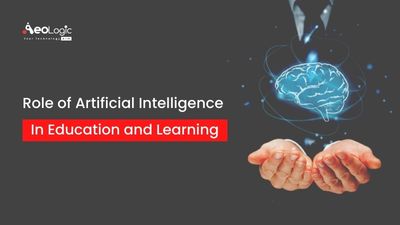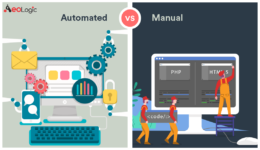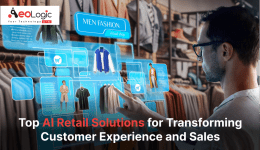Students are not all the same. What one student understands in one way, another may not grasp in the same way. Everyone moves at their own rate. Some individuals grasp information quickly, while others take their time. However, this does not exclude slow learners from catching up with others. That is why personalized learning is essential in order for everyone to learn at their own speed. There is no pushing or limiting. In this blog post, we will explain the main role of artificial intelligence in education and learning.
Let’s begin!
Technology in education includes more than just interactive whiteboards and iPads. AI has been increasingly significant in improving the teaching experience for both professors and students in recent years.
This fruitful partnership between AI and education is now a reality, and it is poised to change the entire sector in the not-too-distant future.
As AI becomes an increasingly important part of our daily lives, it’s no surprise that educational systems are racing to keep up with the requirement to cultivate more talent in order to keep the AI growth engine running.
Artificial intelligence has the potential to automate grading, generate personalized learning experiences, discover curricular gaps, and deliver valuable insights. These objectives can only be met if AI is applied effectively, with intelligent integration of content and processes.
Big Data & Analytics: Remodeling your raw technical data towards clear business information
Role of Artificial Intelligence in Education and Learning
- Learning with AI (for example, using AI-powered tools in the classroom),
- Learning about AI (its technologies and methodologies), and
- Preparing for AI (e.g., enabling all citizens to better understand the potential impact of AI).
Learning with Artificial Intelligence
Individualizes Education
AI-powered educational tools can identify gaps in individual students’ education and create a study guide tailored to their specific needs. This contributes to an exceptionally efficient system in which the teacher understands what the student needs and can provide assistance exactly where it is required.
AI-powered technologies can also provide feedback on how students react to various teaching styles and practise, assisting teachers in determining the most effective teaching approaches.
Reduces Workload
One of the most time-consuming components of teaching is grading. Even when shared among TAs, grading students can be time-consuming.
Fortunately, AI-powered solutions can assist teachers in grading and assessing pupils, freeing them up to participate in more student interaction and other in-class activities.
Increases Confidence
Students are afraid of attempting and failing in front of teachers or peers, or of being asked a question and not knowing the answer.
However, AI tools can directly help address this by creating a judgment-free system in which students can feel comfortable engaging in the classroom. Because AI systems learn by trial and error, they are the greatest educators for this type of learning. When kids spend time with AI, it boosts their confidence and performance over time.
Also Read: How to Grow Business Through Blockchain Technology?
Assists in the matching of students and universities
When used effectively, AI technology can be used in the educational sector to gather data on prospective students and assist them to match up with the university that best matches them. It also aids students in their course selection and enhances their overall university experience.
Choosing the right university is currently a hassle for the majority of young people. But if we use AI-powered data. It will become as simple as selecting a movie on Netflix, with the finest universities advised based on your particular background and skill set.
Tracks the Progress of Students
Rather than relying on annual report sheets to establish student success, AI technology can assist teachers in monitoring and tracking their students’ development on centralised dashboards. This invariably allows teachers to interact with students more effectively and analyse their performance and progress in real-time.
Real-world examples of AI-based solutions in education: Duolingo, Brainly, ThinkerMath, and Byju’s
Learning about Artificial Intelligence
Artificial intelligence is classified into several categories based on the machine’s ability to use past experiences to predict future judgments, memory, and self-awareness.
Machine Learning
It is one of the applications of AI in which machines are not explicitly taught to execute specific tasks; rather, they learn and improve through experience. Machine learning algorithms include Unsupervised Learning, Supervised Learning, and Reinforcement Learning.
The algorithm in Unsupervised Learning does not act on classified information. Supervised Learning deduces a function from training data, which comprises a set of input objects and the intended output. Machines utilise reinforcement learning to take appropriate behaviours to improve the reward in order to determine the best option that should be considered.
NLP (Natural Language Processing)
It is the interplay of computers and human language in which computers are programmed to process natural languages. Machine Learning is a dependable tool for NLP to extract meaning from human languages. The machine in NLP captures the audio of a human conversation. The audio-to-text exchange then occurs, and the text is processed where the data is transformed into audio. The system then uses the sounds to respond to humans.
For example, IVR (Interactive Voice Response) software is used in contact centres, language translation tools such as Google Translate, and word processors like as Microsoft Word to check the quality of grammar in text.
Also Read: Why Is CRM Software a Game-changer When It Comes to Delivering Better Customer Experiences?
Automation and Robotics
The goal of automation is to have machines perform boring and repetitive work, which improves productivity and results in more cost-effective and efficient results. Many businesses automate using machine learning, neural networks, and graphs. Consider the CAPTCHA technique.
Machine Vision
Machines can capture and analyse visual data. Cameras are used to capture visual information, analogue to digital conversion is used to transform the image to digital data, and digital signal processing is used to process the data. The obtained information is then fed into a computer. Signature recognition, pattern recognition, and medical picture analysis are a few examples.
Also Read: The Benefits of Cloud-Native Applications in Manufacturing
Preparing for Artificial Intelligence
AI is becoming more powerful in our lives. The majority of our daily activities are influenced by calculations or algorithms that outperform human-level performance. If AI takes over monotonous and dangerous tasks, humans will be freed up to work on other projects.
On Business
The business circle is the one where AI can deliver plenty of advantages. Initially, AI generates many job prospects for creative professionals, such as Programmers, Data Engineers, and Data Scientists, who work on difficult data and construct large algorithms that are valuable to businesses. For example, AI can offer things to customers based on their search history and activity, which can help businesses increase sales.
Concerning Healthcare
Although artificial intelligence is a sophisticated tool, it is assisting physicians and doctors in the healthcare field to discover something new every day that could never replace the steadiness and efficiency of a human hand. Nonetheless, it can help to reduce human effort.
Qualified experts provide assistance to doctors in a variety of ways. AI has developed a plethora of tools and procedures that have aided doctors’ jobs, particularly colleague surgeons.
Regarding Industries
Production rates and quality are the most vulnerable aspects of the industrial sector. AI has reduced the number of tasks that require human labour as technology has advanced. AI is beneficial to organisations since it allows owners to uncover new facets of their profession.
It has not only powered current enterprises but has also enabled countless new startup businesses to get up and running quickly. The introduction of AI sectors has also benefited the manufacturing sector of industries.
Automotive
With the introduction of autonomous vehicles and autonomous navigation, we can already see how AI is influencing the world of transportation and autos. AI will also have a significant impact on production, particularly in the automotive industry.
Cybersecurity
Many corporate leaders are concerned about cybersecurity. AI and machine learning will be important technologies for detecting and forecasting cybersecurity threats. AI will also be a valuable asset for financial security, as it can process vast amounts of data to predict and detect cases of fraud.
E-Commerce
Artificial intelligence (AI) will be integral to every facet of e-commerce in the near future, from customer service to promotion to order processing and delivery. We can expect AI to continue to drive e-commerce in the future, particularly through chatbots, shopper customization, image-based targeting advertising, and warehouse and inventory automation.
Application development: Boost your business plans with customized applications.
Conclusion
If you are tech knowledgeable, you should go deep and learn everything you can about interfacing with AI. If your strengths lay elsewhere, it is critical to recognise that AI will have a significant impact, and you should strive to understand the principles of how it works in various industries to the best of your ability. With the most recent advances in artificial intelligence (AI), reaching human-like intelligence is increasingly becoming a possibility.
Artificial intelligence is here to stay, whether we like it or not. The best approach to move forward is to be aware of and adapt to new technology, including AI.






